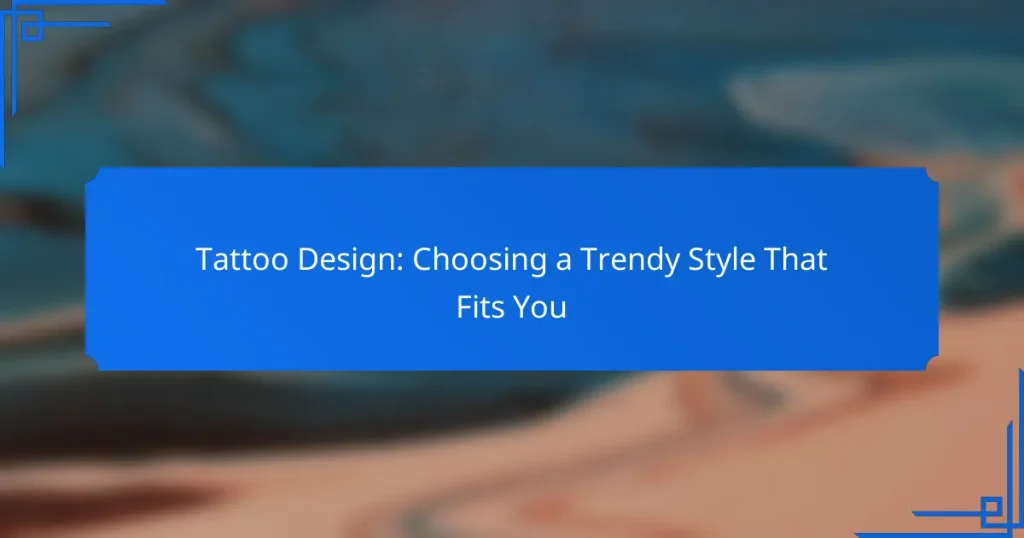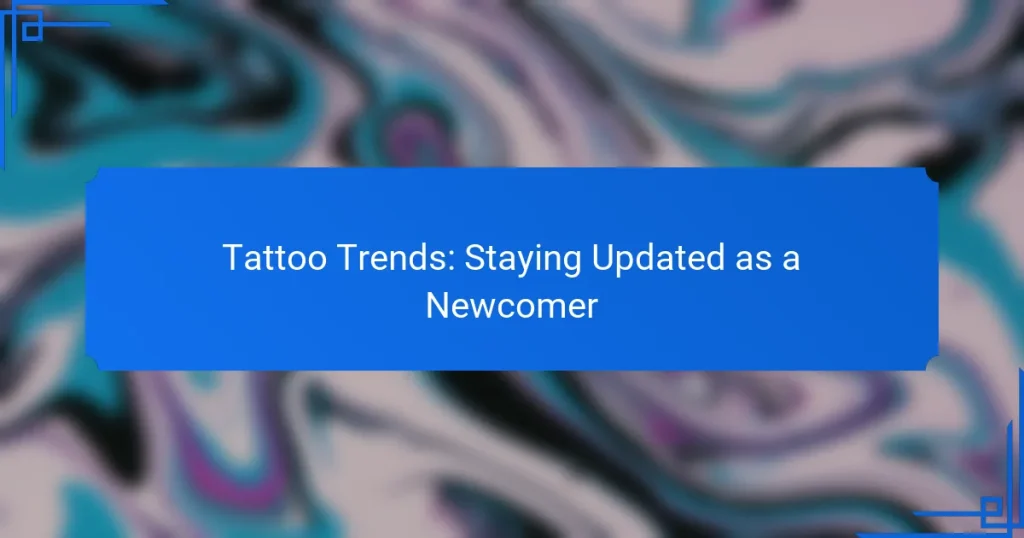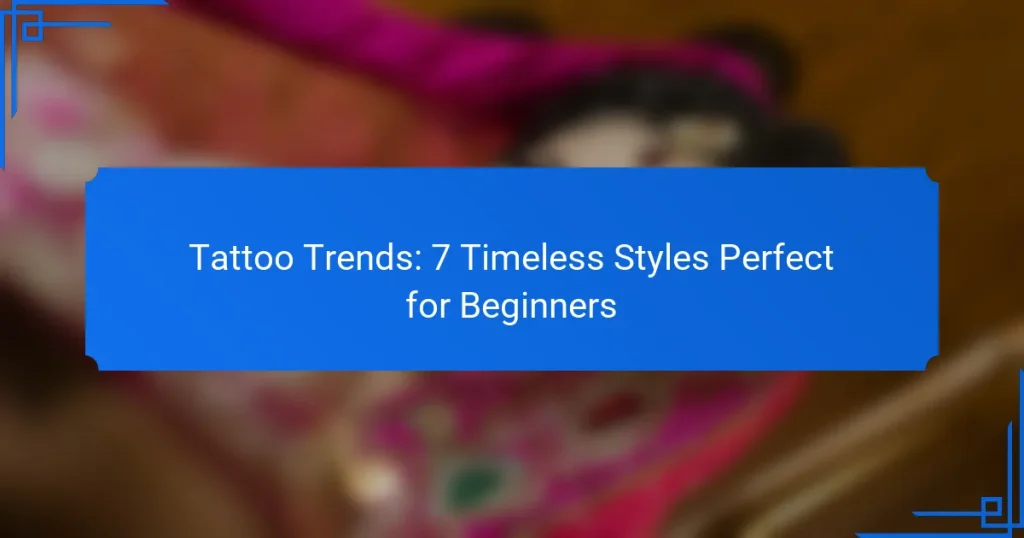For those new to the world of tattoos, the latest trends emphasize simplicity and personal expression. Styles such as minimalist designs, watercolor tattoos, and geometric patterns are particularly popular, allowing individuals to showcase their unique aesthetics and meanings. It’s essential to explore these options and consult with professionals to find a design that resonates with your identity. Additionally, understanding proper aftercare is vital for maintaining the quality and vibrancy of your new ink.
Tattoo Trends: 7 Styles Every Beginner Should Consider
Tattoo Trends: Staying Updated as a Newcomer
Tattoo Artists: 7 Influential Creators Setting Trends for Beginners
Tattoo Trends: Social Media’s Impact on Beginners
Tattoo Trends: 7 Popular Styles for First-Time Clients
Tattoo Trends: 7 Timeless Styles Perfect for Beginners
What Are the Latest Tattoo Trends for Beginners?
The latest tattoo trends for beginners focus on simplicity and personal expression. Popular styles include minimalist designs, watercolor tattoos, geometric patterns, floral motifs, and fine line tattoos, each offering unique aesthetics and meanings.
Minimalist designs
Minimalist tattoos emphasize simplicity and clean lines, making them ideal for beginners. These designs often feature small symbols or shapes that convey a personal message or sentiment without excessive detail.
When choosing a minimalist tattoo, consider its placement on the body, as smaller designs can be easily hidden or displayed. Common choices include small hearts, arrows, or initials.
Watercolor tattoos
Watercolor tattoos mimic the look of watercolor paintings, featuring vibrant colors and fluid designs. This style is appealing for beginners who want a tattoo that stands out and showcases artistic flair.
Keep in mind that watercolor tattoos can fade faster than traditional styles due to their lighter ink application. Regular touch-ups may be necessary to maintain their vivid appearance.
Geometric patterns
Geometric tattoos use shapes and lines to create visually striking designs. They can range from simple triangles to complex mandalas, making them versatile for various personal styles.
For beginners, starting with basic geometric shapes can help ease the tattoo experience. Consider how these patterns can be combined with other elements for a more personalized touch.
Floral motifs
Floral tattoos are timeless and can be adapted to fit any personal style. They often symbolize beauty, growth, and nature, making them popular among beginners seeking meaningful designs.
When selecting a floral tattoo, think about the type of flower and its significance. For example, roses symbolize love, while lotus flowers represent purity and rebirth.
Fine line tattoos
Fine line tattoos are characterized by their delicate, thin lines and intricate details. This trend is perfect for beginners who prefer subtlety over bold designs.
These tattoos can depict anything from simple outlines to detailed illustrations. Ensure you choose an experienced artist, as fine line work requires precision to avoid blurring over time.
How to Choose the Right Tattoo Style?
Choosing the right tattoo style involves understanding your personal preferences, exploring various designs, and consulting with professionals. Consider what resonates with you and how different styles may reflect your identity.
Consider personal interests
Your personal interests play a crucial role in selecting a tattoo style. Think about your hobbies, passions, and values—these can inspire meaningful designs. For instance, if you love nature, you might opt for floral or animal motifs.
Additionally, consider your lifestyle and how a tattoo might fit into it. A bold, intricate design may suit someone with a creative profession, while a minimalist style might appeal to those who prefer simplicity.
Research popular styles
Familiarizing yourself with popular tattoo styles can help narrow down your choices. Common styles include traditional, realism, tribal, watercolor, and geometric. Each style has unique characteristics and techniques, so understanding these can guide your decision.
Look for inspiration online through social media platforms or tattoo artist portfolios. This can give you a sense of what styles resonate with you and help you visualize how they might look on your skin.
Consult with tattoo artists
Engaging with tattoo artists is essential in choosing the right style. They can provide valuable insights based on their expertise and experience. Discuss your ideas and preferences, and ask for their recommendations based on your skin type and placement.
Many artists have a signature style, so finding one whose work aligns with your vision can enhance the final outcome. Don’t hesitate to ask for a consultation to explore your options before making a commitment.
What Should Beginners Know About Tattoo Aftercare?
Beginners should understand that proper tattoo aftercare is crucial for healing and preserving the quality of their new ink. Following a few key practices can significantly reduce the risk of infection and ensure vibrant colors.
Keep the tattoo clean
Maintaining cleanliness is essential for tattoo aftercare. Gently wash the tattoo with mild, unscented soap and lukewarm water at least twice a day. Avoid scrubbing; instead, use your hands to lightly cleanse the area.
After washing, pat the tattoo dry with a clean towel or let it air dry. This helps prevent bacteria from entering the skin and reduces the risk of infection.
Moisturize regularly
Regular moisturizing is vital for keeping the tattoo hydrated and promoting healing. Apply a thin layer of fragrance-free lotion or a specialized tattoo aftercare ointment several times a day, especially after washing.
Avoid over-moisturizing, as this can lead to clogged pores. A good rule of thumb is to apply moisturizer whenever the tattoo feels dry or tight, but not excessively.
Avoid sun exposure
Sun exposure can fade tattoos and damage healing skin, so it’s important to keep your tattoo covered when outdoors. Use clothing or a bandage to shield the area from direct sunlight for at least a few weeks after getting inked.
Once healed, apply a broad-spectrum sunscreen with a high SPF to protect the tattoo from UV rays. This will help maintain the vibrancy of the colors and prevent premature fading.
How to Find a Reputable Tattoo Artist?
Finding a reputable tattoo artist is crucial for ensuring a safe and satisfying tattoo experience. Look for artists with positive reviews, a strong portfolio, and a clean, welcoming studio environment.
Check online reviews
Online reviews are a valuable resource when searching for a reputable tattoo artist. Websites like Yelp, Google Reviews, and social media platforms can provide insights into the experiences of previous clients. Aim for artists with a high number of positive reviews and consistent feedback regarding their professionalism and skill.
Be cautious of artists with numerous negative reviews or complaints about hygiene practices. A few critical reviews can be normal, but patterns of dissatisfaction should raise red flags.
Visit local studios
Visiting local tattoo studios allows you to assess the environment and cleanliness firsthand. Pay attention to how the studio is maintained, including the state of the equipment and the overall atmosphere. A reputable studio should have a welcoming vibe and adhere to strict hygiene standards.
Take note of how the staff interacts with clients. Friendly and knowledgeable artists who are willing to answer your questions can indicate a professional establishment. If possible, ask to see the studio’s health and safety certifications.
Ask for artist portfolios
Reviewing an artist’s portfolio is essential to gauge their style and skill level. Portfolios should showcase a variety of completed tattoos, highlighting the artist’s versatility and expertise. Look for consistency in quality and attention to detail across different pieces.
Don’t hesitate to ask the artist about their techniques and inspirations. A good artist will be open to discussing their work and should be able to provide references or examples that align with your desired tattoo style.
What Are Common Mistakes Beginners Make?
Beginners often make several common mistakes when getting their first tattoo, which can lead to dissatisfaction or complications. Understanding these pitfalls can help ensure a more positive tattoo experience.
Not researching designs
Failing to thoroughly research tattoo designs can result in regret later on. Beginners should spend time exploring various styles, meanings, and artists’ portfolios to find a design that resonates with them personally.
Consider creating a mood board or saving images that inspire you. This can help clarify your vision and make it easier to communicate with your tattoo artist.
Choosing the wrong placement
The placement of a tattoo significantly affects its visibility and personal significance. Beginners should think about how often they want to show their tattoo and how it may change with their body over time.
For example, tattoos on the forearm or wrist are more visible, while those on the back or thigh can be easily concealed. It’s also wise to consider how the tattoo will look as your body ages.
Ignoring aftercare instructions
Proper aftercare is crucial for healing and maintaining the quality of a tattoo. Beginners often overlook the importance of following their artist’s aftercare instructions, which can lead to infections or fading.
Common aftercare steps include keeping the tattoo clean, applying ointment, and avoiding sun exposure. Make sure to ask your artist for specific guidelines and follow them closely for the best results.
What Are the Costs of Getting a Tattoo?
The costs of getting a tattoo can vary widely based on factors such as size, design complexity, and the artist’s experience. Generally, prices range from around $50 for small, simple tattoos to several hundred dollars for larger, intricate designs.
Factors Influencing Tattoo Costs
Several key factors influence the overall cost of a tattoo. The size of the tattoo is a primary determinant; larger tattoos typically require more time and materials, thus increasing the price. Additionally, the complexity of the design plays a crucial role; detailed artwork often commands higher fees due to the skill and time required.
The artist’s experience and reputation also significantly impact pricing. Established artists with a strong portfolio may charge more, reflecting their expertise and demand. Location matters too; studios in urban areas might have higher rates compared to those in smaller towns.
Average Price Ranges
On average, you can expect to pay between $50 and $150 for small tattoos, while medium-sized ones may cost between $150 and $500. Large tattoos or custom designs can range from $500 to over $2,000, depending on the intricacy and time involved.
Hourly rates for tattoo artists typically range from $100 to $300, depending on their skill level and the studio’s location. It’s advisable to inquire about the artist’s hourly rate before committing to a design.
Additional Costs to Consider
In addition to the base price of the tattoo, there are other potential costs to consider. Aftercare products, such as ointments and moisturizers, can add an extra $20 to $50 to your total expenses. Some studios may also charge a deposit, which is often deducted from the final price but is non-refundable if you cancel.
Travel expenses may be relevant if you choose to visit a renowned artist or studio located far from your home. Always factor in these additional costs when budgeting for your tattoo to avoid surprises.






